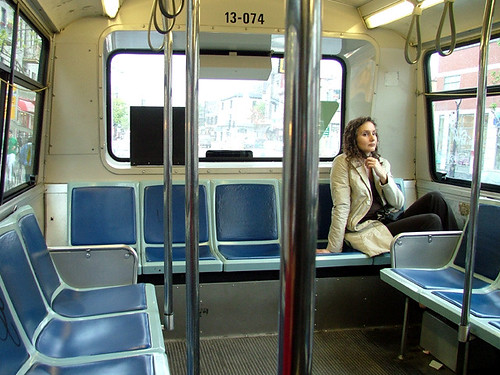In his post urging Montreal to get bent, Chris Erb briefly mentioned the mayor’s plan to overhaul Montreal’s bus network. Monday’s Gazette gave a pretty good outline of what’s included in the plan, including some pretty obvious improvements — like adding more buses. The STM’s current fleet of 1,600 will be increased to 2,100, along with an extra 202 bendy buses on busy routes like the 535 Park/Côte-des-Neiges. Here are some more highlights:
- — 240 kilometres of new reserved bus lanes on streets like Beaubien, Rosemont, Notre-Dame East, Sauvé and Côte-Vertu. Priority signals will be installed at intersections to give buses a head start on other traffic.
- — Metrobus and express service will be extended between the morning and afternoon rush hours. More buses will be added just before and after rush hour on about 30 crowded routes.
- — Intercoms will be installed on buses to allow drivers to announce the next stop; GPS will track each bus in real time and its estimated time of arrival will be displayed at bus stops.
- — Limited-stop service will be introduced to busy routes, creating a two-tier system of express and local buses.
- — The city will study the possibility of providing free transit service to university students.
- — Bus service will be improved in the West Island and in the Southwest, Verdun, LaSalle and Lachine boroughs.
As local cynic Steve Faguy points out on his esteemable blog, though, some of the suggested improvements are awfully gimmicky. The idea of tracking buses by GPS and displaying their estimated time of arrival at bus stops would be great, but I’ve seen this technology in action on Vancouver’s B-Line express buses and it’s far from reliable. It certainly isn’t much more useful than having a plain old schedule posted at each stop. Besides, considering the STM still isn’t able to tell metro riders when the next train is coming — only Berri and McGill stations have Metrovision screens, despite plans to have installed them in post stations by the end of 2006 — I wouldn’t be too optimistic about its ability to successful apply this to the bus network.
The notion of providing free transit service to students is a bit iffy, too. In Vancouver and Calgary, $22 per month is tacked onto the tuition bill of university students in exchange for a U-Pass that lets them ride transit. This isn’t exactly free, though, since students are still paying: it’s basically just a back-end version of the reduced-fare passes students already get with a Carte Privilège.
The Gazette reports that the new articulated buses will come into service between 2009 and 2011. Today, it also reported that the STM will buy new hybrid buses that it will test on busy west end routes (plus the 80) next year. There’s no word on when the other buses will hit the street, but a representative from the STM told me last month that the agency is gearing up to increase bus and metro service next year — so we might not have to wait much longer until we start seeing the more efficient and frequent public transit this city so badly needs.


One comment
How about air conditioning on the buses and metro? Riding the bus in any major US city is a pleasure — really — a pleasure. It is nice and cool in the summer thanks to air conditioning. Buses are much better than taxis in that way.
Montreal is hot enough to benefit from AC from May to September — that’s 41 percent of the year.
Any transit plan that doesn’t address the *quality* of service is worthless — no matter how many more buses they add.
There is no way a guy or gal in a business suit is going to leave the car at home at take public transit if they show up a work drenched in sweat after being packed in on a bus with in indoor temp of more than 29 degree Celsius.